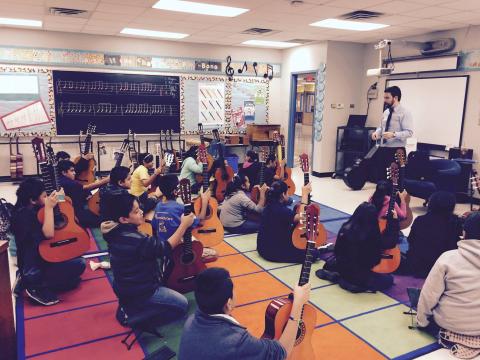
As the school year gathers momentum, we thought we'd share some stories of how your colleagues address certain challenges they face in the guitar classroom. For the first edition in a continuing series, we'll hear from Vikki Schwarz, a veteran music teacher at Widén Elementary here in Austin, Texas. Vikki has been using GuitarCurriculum.com to integrate guitar into her general music classes since 2013.
At Widén Elementary, we start guitar in 4th grade. We spend a week learning how to sit and hold the guitar properly, how to not pretend like we're playing rock n' roll with an electric guitar - that's always a fun part.
Students verbalize simple ta and ta-di rhythms and work on using all the syllables. We sing the songs from GuitarCurriculum.com, play them on recorder, and then play them on guitar. Eventually, the class learns all the parts, and we divide them into sections. We do a number of performances, changing parts with each repetition, and then I let them pick their favorite part to play. Somebody always wants that repeated E on "Blue Magic," even though it's the hardest part - they have to keep a steady pulse for everybody else.
Last year we had 58 guitarists in 5th grade, but this year we have 81. When they all play together, it feels like the biggest ensemble out there, which is really cool. They take a lot of pride in that.
Adapting to cultural differences
My school is 93% Hispanic, with a lot of kids just arriving in the US, and many only speak Spanish. I can't tell them to play the B string, I tell them to play Ti, because in Mexico and other Central or South American countries, letter names are identified with solfège. The US is one of the few countries that uses letters for note names.
Teaching large groups of students with diverse experience levels
I pair really strong students with the ones struggling, or having trouble understanding me, to help them learn things like how to hold the guitar, how to put their fingers on the strings. Those kids become ambassadors of the classroom, which is really cool. Kids learn much faster from each other than from me. But kids that are strong in one area might be weaker in another, so it works out nicely, because there's an egalitarian sharing of information.
Do you have any strategies for dealing with common challenges in your classroom? We'd love to hear from you!